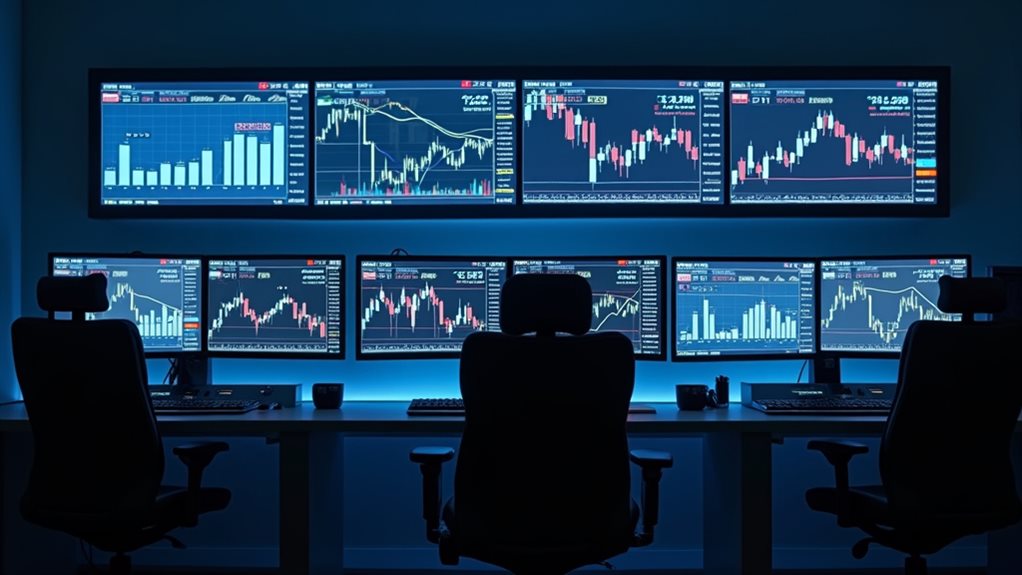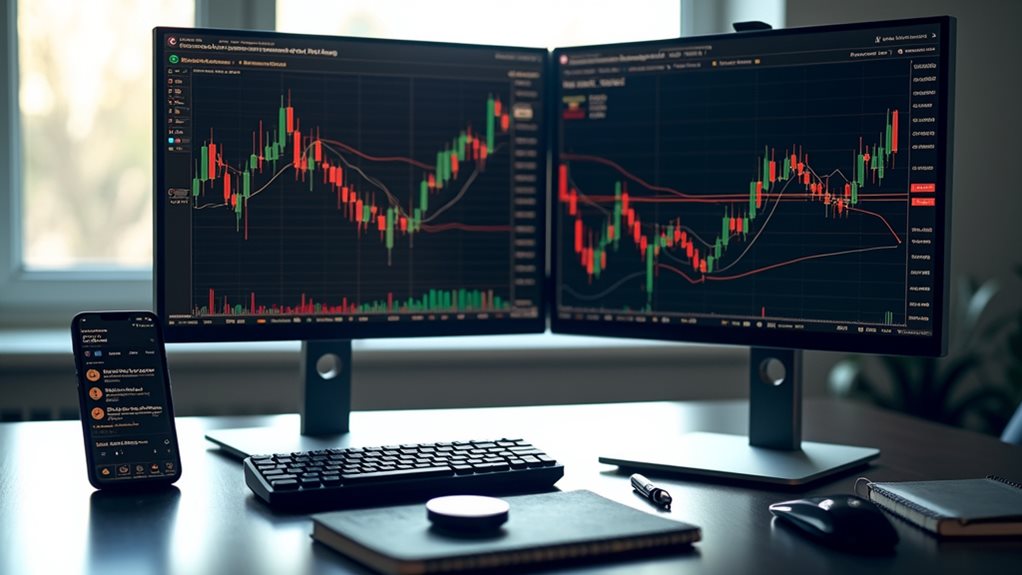Crypto day trading isn't a get-rich-quick scheme. You'll need proper tools, secure exchanges with good liquidity, and solid technical analysis skills. Start with paper trading to practice without losing real money. Your success depends on managing risk—set stop-losses immediately and never risk more than 1-2% per trade. Emotions will wreck your account faster than market crashes. Stick to fixed trading hours, take breaks, and remember: even veteran traders blow up accounts sometimes. The next steps reveal what separates winners from losers.
Complete Day Trading Crypto Guide for Beginners in 10 Steps

Diving into crypto day trading isn't for the faint of heart. It's a wild ride where fortunes change faster than your social media feed refreshes. Trust me.
First, arm yourself with crucial tools. Charting platforms? Non-negotiable. You'll drown without them. Trading indicators help spot market trends before they're obvious to the masses. The pros see patterns; amateurs see chaos. Ensure your exchange has robust security features to protect your trading activities.
Your strategy matters. Scalping works for some, trend following for others. Pick your poison.
Strategy isn't one-size-fits-all. Find your edge—scalp the micro-moves or ride the bigger waves. Choose wisely.
Risk management isn't sexy, but it keeps you alive. Set those stop-losses. Seriously.
Choose high-liquidity cryptos when starting. Bitcoin's boring but reliable. Altcoins? More exciting, more dangerous. Paper trading lets you practice strategies without real money until you're confident in your approach.
Finally, technical analysis isn't optional—it's survival. RSI, MACD, moving averages. Learn them or lose money. Remember that the crypto market offers 24/7 trading opportunities unlike traditional markets, giving you flexibility but demanding constant vigilance.
Understanding the Cryptocurrency Market Ecosystem
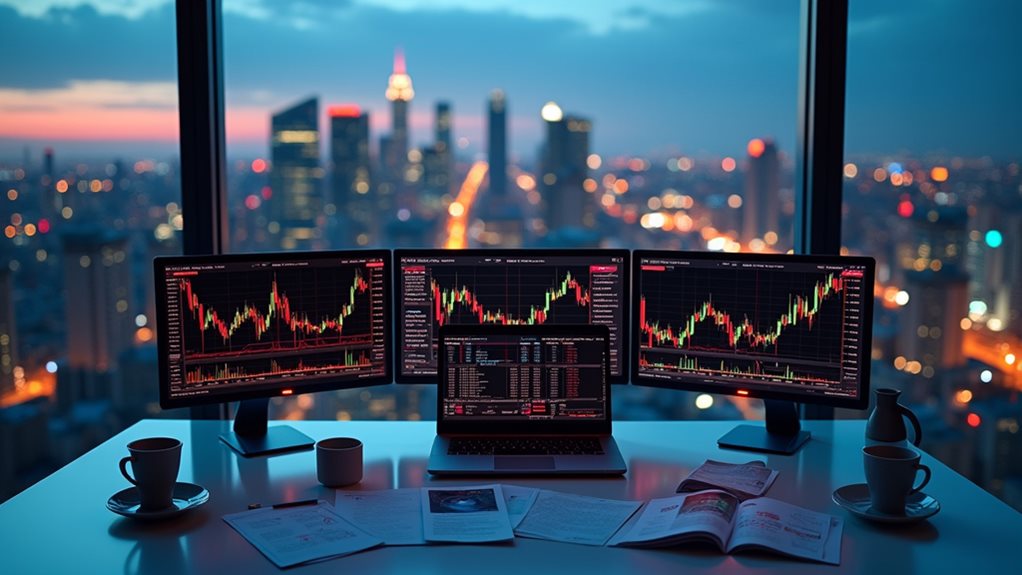
Before you jump into the crypto day trading chaos, you've got to understand what you're actually dealing with. The crypto market isn't your grandfather's stock exchange—it's a wild west of blockchain technology, digital assets, and 24/7 trading. Your trading psychology will make or break you in this ecosystem. Trust me.
- Blockchain networks come in different flavors—public (Bitcoin), private (corporate), and consortium-based (shared access).
- Crypto exchanges split between centralized (regulated) and decentralized (no middleman).
- Market trends move at lightning speed, influenced by news, events, and institutional money.
- DeFi platforms offer new investment strategies beyond simple buy/sell.
- Security measures are non-negotiable—lose your keys, lose your coins.
The market doesn't care about your feelings. Period. Remember that the inherent volatility of cryptocurrencies presents both significant opportunities and substantial risks, especially for day traders. Recent multi-signature wallet breaches demonstrate why robust security measures are crucial for protecting your investments. Successful traders implement stop-loss orders to manage potential losses and protect their capital when market conditions suddenly change.
Setting Up Your Trading Station and Essential Tools
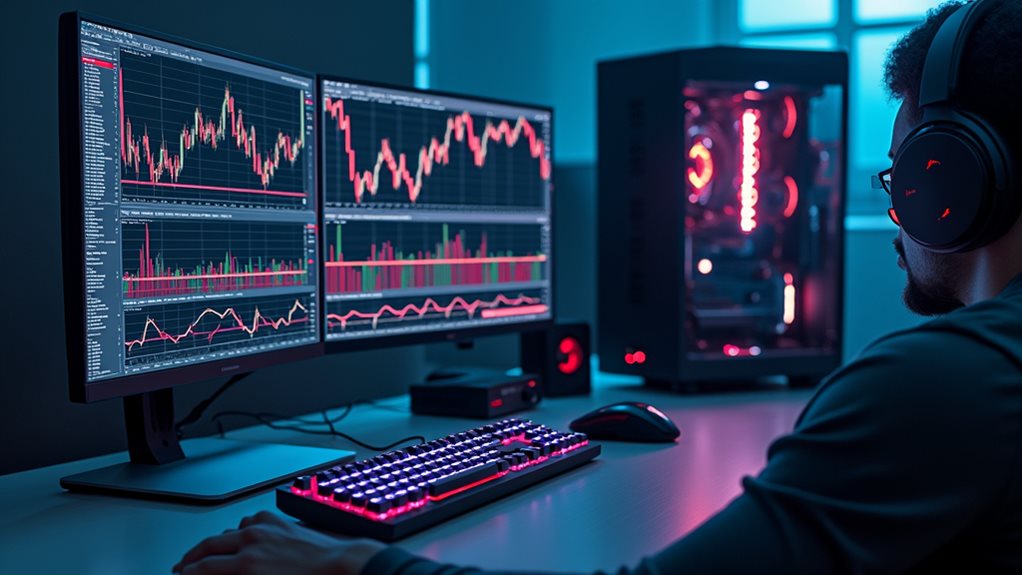
Once you've wrapped your head around the crypto ecosystem, you need a battle station worthy of your trading ambitions. A reliable computer and fast internet connection aren't optional—they're your lifeline.
Your trading software arsenal should include charting platforms like TradingView or MetaTrader. They're non-negotiable for spotting trends before they happen.
Powerful charting tools aren't optional extras—they're your crystal ball in a market that waits for no one.
Not at your desk? Mobile apps keep you in the game 24/7.
Risk management isn't sexy, but it'll save your portfolio when things go sideways. Stop-loss tools are your financial bodyguards. Popular exchanges like Coinbase or Binance provide essential risk management features for beginners. Consider adding trading bots to your setup to help eliminate emotional decision-making during volatile market conditions.
Don't skimp on news aggregators either. The crypto market doesn't care if you missed that regulatory announcement while scrolling TikTok.
Always implement two-factor authentication to protect your trading accounts from potential security breaches.
Remember: Great traders aren't born with magical powers—they just have better tools.
Selecting the Right Exchanges for Day Trading
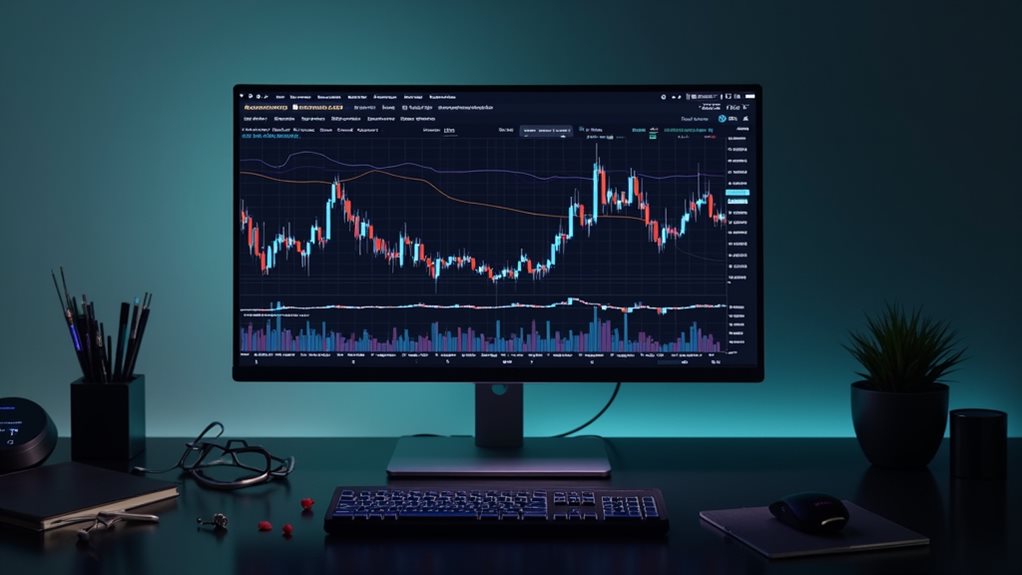
Where you trade matters just as much as what you trade. Choosing the wrong exchange can cost you serious money and opportunities. Your success hinges on finding platforms with the right exchange features for your trading style. Don't just pick the first one you see.
- Liquidity is king – Binance and Bitget offer high liquidity for quick execution when seconds count.
- Fees will eat your profits – Look for tiered structures like Binance and Phemex that reward volume.
- Security isn't optional – Gemini and Bitget use multi-signature wallets and full-reserve policies.
- User interface matters – Bybit and Bitget won't confuse you with overcomplicated screens.
- Advanced trading tools separate pros from amateurs – Real-time charts and diverse order types on Binance and Gemini give you an edge.
Many platforms like CEX.IO provide diverse payment options including credit cards, bank transfers, and e-wallets for convenient funding.
Make sure to check if the exchange offers automation tools that can help execute your strategies consistently and reduce emotional trading decisions.
Consider using Binance.US for its maker fee discounts when executing high-volume trading strategies.
Mastering Technical Analysis Fundamentals

Technical analysis forms the backbone of successful day trading. You can't merely throw money at random coins and expect profits—that's how you go broke, fast.
Start with chart patterns like candlesticks; they're not merely pretty pictures but actual market psychology on display.
Learn to spot trends. Trend analysis isn't rocket science, but missing an obvious downtrend will wreck your portfolio.
With Mantra OM leading 2025's altcoin gains, understanding momentum indicators is crucial.
Support and resistance levels? They're like invisible force fields where prices bounce off repeatedly. Ignore them at your peril.
Moving averages, RSI, and MACD aren't fancy alphabet soup—they're your early warning system. When RSI says "overbought," it means the party's ending soon.
Volume confirms everything. No volume? No trust.
Fibonacci retracement levels can help identify potential reversal zones where prices might find support and resistance based on mathematical ratios.
Developing a comprehensive trading plan that outlines your strategy, risk tolerance, and entry/exit criteria is essential for consistent results in the volatile crypto market.
Developing Your First Day Trading Strategy

- Start with scalping—quick in-and-out trades capturing small price movements with clear entry signals.
- Try momentum trading when crypto's on a tear—ride the wave but don't get greedy.
- Use range trading between support and resistance levels—boring but effective.
- Set firm exit strategies BEFORE entering trades—no exceptions.
- Test your strategy with small amounts first—paper trading is for cowards.
- Consider using trading bots to automate your strategy execution, especially for arbitrage opportunities across different exchanges.
- Pay close attention to Bitcoin's price movements since BTC influence typically drives the entire altcoin market.
- Monitor exchange outflows as large withdrawals often precede significant price increases.
Remember: the strategy that works for your crypto-obsessed neighbor might be a disaster for you.
Markets change. Adapt or die.
Implementing Effective Risk Management Rules

Risk management isn't optional in crypto day trading—it's your lifeline. Without it, you're basically jumping off a cliff without a parachute. Seriously.
Set stop loss strategies immediately after entering trades. No exceptions. Tools exist to calculate ideal levels based on your tolerance—use them. Some systems even adjust automatically as prices climb. Nice.
Stop losses aren't optional—they're mandatory survival gear in the crypto jungle. Set them immediately or prepare to be liquidated.
Portfolio diversification? Absolutely critical. Don't put everything in one crypto, no matter how "revolutionary" it seems. Spread investments across different sectors—DeFi, NFTs, whatever. Analyze correlations to avoid similar assets. Since smart contract vulnerabilities pose significant risks, diversifying across multiple platforms adds an extra safety layer. Periodic rebalancing of your portfolio is essential to maintain proper diversification over time.
Control your trade sizes. Never risk more than a small percentage on a single trade. High volatility in cryptocurrency markets makes strict position sizing non-negotiable. The market doesn't care about your feelings or financial goals. It'll crush you anyway.
Monitor market news constantly. Things change fast. Adapt or die.
Managing Trading Psychology and Emotions
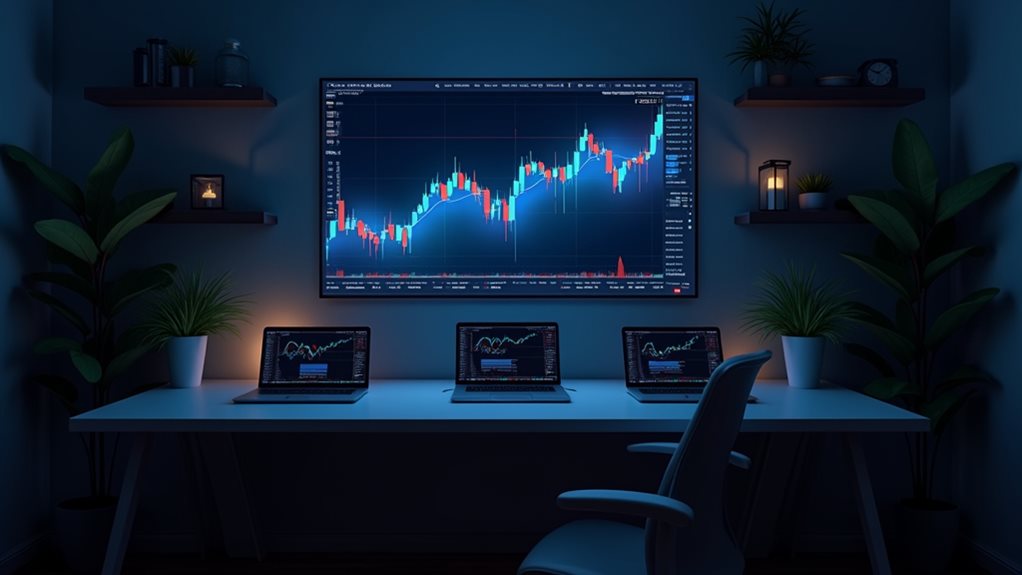
Your mind is the ultimate trading weapon—or your biggest liability. Those crypto charts aren't just displaying prices—they're triggering your fear, greed, and every bias you didn't know you had. Emotional regulation isn't optional; it's survival. Like bear market recoveries, trading success requires patience and a level head.
- FOMO will drive you to buy high (then cry later)
- Loss aversion keeps dead trades alive way too long
- Confirmation bias makes you see only what supports your position
- Overconfidence turns winning streaks into account-draining disasters
- Fear causes panic selling at the worst possible moments
Let's be real—your cognitive biases are working overtime in this market. The difference between profitable traders and the rest? They recognize when emotions are driving the bus. Successful traders implement trading plans that help them maintain discipline and make rational decisions regardless of market conditions. Developing a growth mindset helps you bounce back from inevitable losses and view them as valuable learning opportunities rather than failures.
Trading without emotional awareness is like driving blindfolded. Stop that.
Starting Small: Paper Trading and Minimal Capital
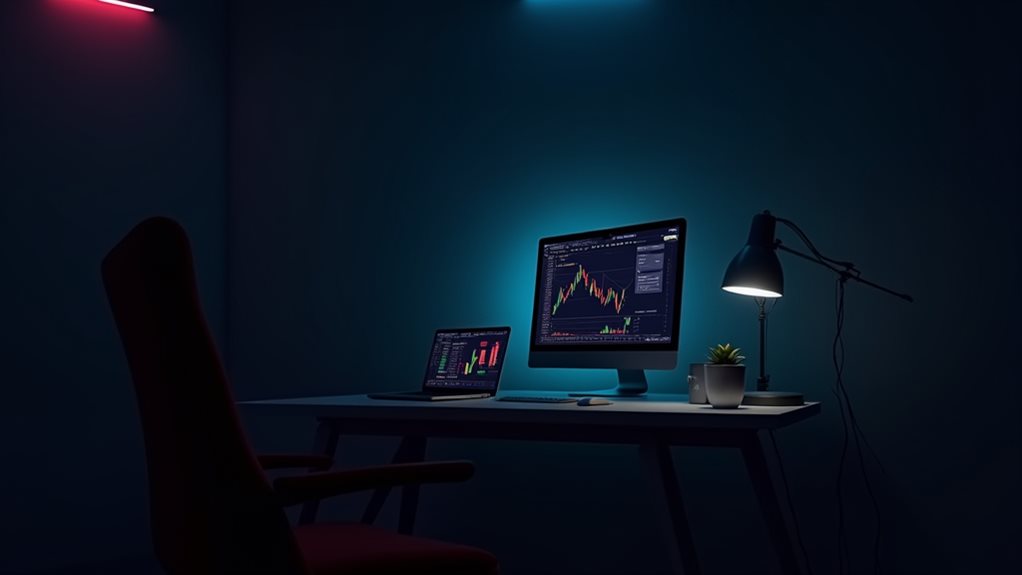
Now that you've recognized your emotional demons, it's time to practice slaying them—without bleeding real money.
Paper trading provides a risk-free sandbox where you can screw up spectacularly without the gut-wrenching pain of actual losses.
Platforms like ProRealTime, TradingSim, and Wall Street Survivor offer virtual funds and realistic market conditions. Perfect for testing those "genius" strategies you've been contemplating.
You'll get comfortable with the interface, practice setting stop-losses, and learn to recognize patterns without the panic of watching your life savings evaporate.
Let's be clear: paper trading isn't perfect. It won't show you slippage or liquidity issues. Your emotions behave differently when real cash isn't on the line. A study from UC Berkeley showed that paper traders tend to manage portfolios better than those who jump straight into real trading.
But it's infinitely better than jumping straight into the crypto shark tank with your rent money.
These simulations create an ideal safe environment for gaining practical experience before committing to real cryptocurrency trading.
Building a Sustainable Trading Routine
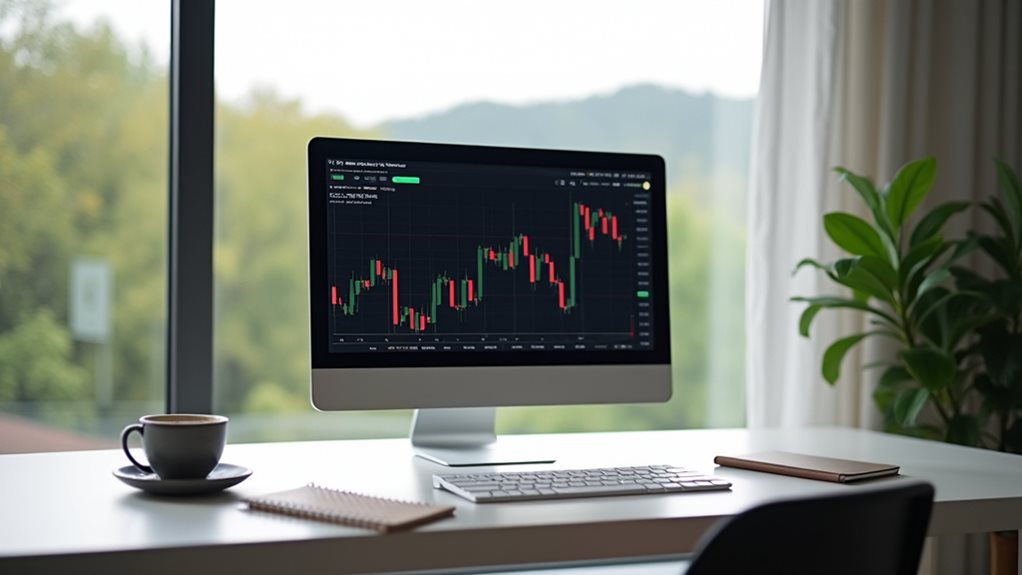
While paper trading prepares you for battle, building a sustainable trading routine transforms you from a panicked rookie into a disciplined crypto warrior. Consistency is your secret weapon. No trader ever conquered the market by randomly jumping in and out whenever they felt like it.
Set up your daily rhythm with these key components:
- Fixed trading hours that align with high-volume market periods
- Regular breaks every 45-60 minutes (your brain isn't built for constant chart-staring)
- Clear daily and weekly goals with specific success metrics
- Alert systems that work FOR you, not control you
- Pre-trading rituals to get your head in the game
With average transaction fees ranging between $0.57-$1.40, frequent trading can accumulate significant costs that eat into your profits. Look, day trading isn't a sprint. The most successful traders aren't the most brilliant—they're the most consistent. Consider practicing HODLing strategies to reduce the environmental impact of frequent trading during your off-hours. Maintaining quality time with family and friends outside of trading hours is essential for mental wellbeing and preventing burnout.
Your routine is what separates the pros from the amateurs.
Frequently Asked Questions
How Are Cryptocurrency Trading Profits Taxed in Different Countries?
You'll find cryptocurrency taxation varies globally under international regulations. In tax-free jurisdictions like Brunei, you pay nothing, while countries like Japan tax you up to 55% on your crypto profits.
Can I Day Trade Crypto Through Retirement Accounts?
Yes, you can day trade crypto in self-directed retirement accounts like SDIRAs. You'll need specialized custodians and effective trading strategies to maneuver this tax-advantaged option while complying with IRS regulations.
How Do Hardware Wallets Integrate With Day Trading Platforms?
Hardware wallets integrate via API connections, allowing you to maintain wallet security while day trading. You'll need to approve transactions on your device, balancing trading efficiency with improved protection against hacking attempts.
What Qualifications or Certifications Benefit Crypto Day Traders?
You'll benefit from Certified Cryptocurrency Trader (CCT) and Certified Bitcoin Professional (CBP) certifications. They improve your crypto trading strategies and risk management techniques while validating your expertise to potential clients and employers.
How Does Cryptocurrency Day Trading Differ From Forex Trading?
When day trading crypto, you'll face higher volatility than forex, requiring unique trading strategies. You're dealing with 24/7 markets, less regulation, lower liquidity, and potentially higher risk-reward scenarios with crypto volatility.


